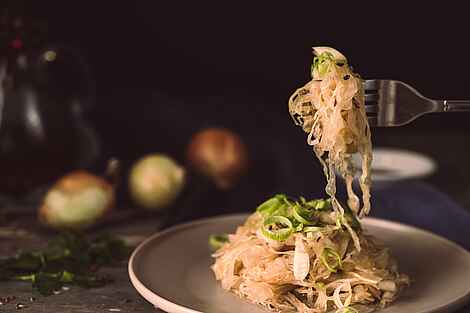A diverse, active microbiota reflects a healthy balanced diet [1]. Conversely a gut microbiota of low diversity is linked to an unbalanced diet. This promotes inflammation and hence chronic diseases. A fibre-rich diet with pulses, wholegrain products, and fruit and vegetables provides dietary protection and is crucial for microbial diversity in the gut. Fermented foods such as kimchi, kombucha and sauerkraut are gaining in popularity. They have been associated with a positive health effect since the early 1900s. Regular consumption of lactic acid fermented foods reduces the risk of type 2 diabetes mellitus as well as cancer and cardiovascular disease [1]. A randomised prospective intervention study has now shown that a diet rich in fermented foods increases the diversity of the gut flora and has a positive effect on the immune system [1]. In contrast, a fibre-rich diet did not produce these changes during the ten-week study period. It can be deduced from this that the immune system receives a rapid boost by supplementing the daily diet with fermented foods.
The study involved 36 healthy subjects. One group of these received an average of 6 ± 2 portions of fermented foods per day, such as yogurt, kefir, buttermilk, sauerkraut and kimchi. The other group received a fibre-rich diet with 45 ± 10 g of fibre per day. The main components of this were vegetables, nuts, pulses and grains. Blood and stool samples were analysed, taken in a three-week period before the study, during the ten-week diet and four weeks afterwards. The measurements made included the microbial composition, microbial metabolites and also immune markers such as inflammatory proteins.
For all the participants on the diet with the fermented foods, a fall was demonstrated in the immune cell activity and the levels of the 19 different inflammatory proteins measured in the blood, such as interleukin 6. This indicates a lower inflammatory activity in the body, which in turn reduces the risk of chronic diseases. The gut flora diversity increased in all test subjects. The bacteria contained in the fermented foods, in particular lactic acid bacteria, support the human gut microbiota and are themselves part of the gut flora, contributing to microbial diversity.
In contrast, none of the 19 inflammatory proteins decreased in the participants with the fibre-rich diet. The gut flora diversity also remained on average unchanged. On the other hand, there was evidence of increased microbial activity in the stool samples measured from the concentration of microbial protein, the ability to breakdown carbohydrates and a change in the synthesis of short-chain fatty acids. It is assumed that a longer intervention would have been necessary to allow the microbial diversity to adapt to the high fibre consumption. For, as is well-known, a fibre-rich diet is beneficial.
Fermentation is a process going back thousands of years, and was primarily used for conserving. In the past, however, it was not known that this also benefited the gut. But the positive effect of these foods on health was discovered early: for instance, eating sauerkraut protected sailors from getting scurvy. This was previously attributed to the presumed high content of vitamin C in sauerkraut which, at approx. 20 mg/100 g, is not significant (for comparison: red pepper has a vitamin C content of approx. 140 mg/100 g) [2]. Perhaps it was the effect of the sauerkraut on the sailors' gut flora that contributed to a more stable immune system?
In Europe, fermented foods are particularly popular in autumn and winter, while in other climatic zones, foods such as kimchi are part of the diet throughout the year. If the gut flora is well nourished, something facilitated by lactic acid fermented foods, then the gut microbiota is active and diverse, and its positive effects are all the greater. A symbiosis with the gut flora in human beings is not just important for health. As far back as 1920, in his 4th lecture in the first medical course, Rudolf Steiner referred to the fact that the formative forces of the gut microbiota are transformed into thinking activity [3]. We can well imagine that free thinking relies on a healthy body in which the life forces are intact. A diverse and active gut microbiome contributes to this. On the other hand, a poorly developed gut flora encourages inflammatory and other pathogenic processes. This shows how brain and gut, thinking and nutrition, are connected, and illustrates the far-reaching effects of our personal nutrition.
See also the article (in German): "Mikrobiota: Beeinflusst unsere Darmmikrobiota das Denken?" https://www.sektion-landwirtschaft.org/ernaehrung/artikel/ea/microbiota
Bibliography
[1] Wastyk HC, Fragiadakis GK, Perelman D, Dahan D, Merrill BD, Yu FB, Topf M, Gonzalez CG, Van Treuren W, Han S, Robinson JL, Elias JE, Sonnenburg ED, Gardner CD, Sonnenburg JL (2021). "Gut-microbiota-targeted diets modulate human immune status", Cell. 184(16):4137-4153, DOI: https://doi.org/10.1016/j.cell.2021.06.019
[2] Elmadfa I, Muskat E, Fritzsche D, Meyer AL (2022). "Die große GU Nährwert Kalorien Tabelle“, 3rd edition, Munich, GU Verlag
[3] Steiner R (2020). "Introducing Anthroposophical Medicine: Twenty Lectures Held in Dornach, Switzerland March 21-April 9, 1920, New York, SteinerBooks Inc (Geisteswissenschaft und Medizin. 20 Vorträge, Dornach 1920 (Erster Ärztekurs)“, 8. Auflage, Basel, Rudolf Steiner Verlag)
